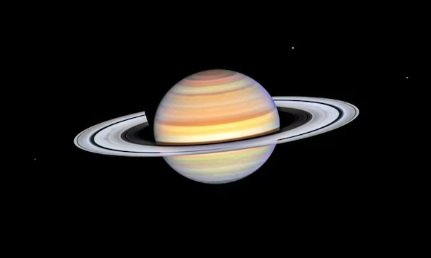In an astronomical phenomenon set to occur in March 2025, Saturn’s iconic rings will appear to vanish from view when observed from Earth. This temporary disappearance is not an actual vanishing act but an optical illusion resulting from Saturn’s orbital dynamics and axial tilt. This rare event gives space enthusiasts an opportunity to witness a celestial occurrence that happens roughly every 13 to 15 years.
The Optical Illusion Explained
Saturn’s tilt, which is about 26.73 degrees, and its long orbital period of nearly 30 Earth years around the Sun, make its rings visible from different angles over time. For a brief moment in 2025, Earth will be in a position where we only see the thin edge of Saturn’s rings. Since the rings are remarkably thin—less than a mile thick—viewing them edge-on from such a distance makes them almost invisible. This phenomenon is akin to looking at the narrow edge of a sheet of paper from far away.
The last time this event occurred was in 2009, and it will continue to recur periodically, allowing future generations to observe the same effect. Though the optical illusion is fleeting, it reveals a fascinating aspect of Saturn’s complex relationship with its rings and the wider cosmos.
Saturn’s Rings: Temporary Illusion, Long-Term Loss
While Saturn’s ring “disappearance” in March 2025 is temporary, the planet is gradually losing its rings for real. NASA has discovered that Saturn’s gravity and magnetic field are pulling ring material toward the planet in a process known as “ring rain.” During this process, the planet sheds enough material to fill an Olympic-sized swimming pool every 30 minutes. Scientists predict that Saturn’s rings could completely disappear in about 300 million years—a timescale long enough to allow us and many future generations to continue enjoying the beauty of the ringed giant.
How Did Saturn’s Rings Form?
Saturn’s rings consist of billions of ice and rock particles, ranging in size from tiny grains of dust to objects as large as mountains. Scientists believe these rings formed about 100 million years ago, possibly the result of two icy moons colliding and shattering into countless fragments.
Fascinating Facts About Saturn’s Rings
- Composition: Saturn’s rings are primarily made of ice, with some rock and dust particles mixed in.
- Width vs. Thickness: While the rings span up to 175,000 miles in width, they are incredibly thin, measuring less than a mile thick.
- Sections: The rings are divided into distinct sections, including the A, B, and C rings, each containing different amounts of material.
- Moons Shaping Rings: Some of Saturn’s moons, such as Pan and Daphnis, create gaps within the rings and help shape them through gravitational forces.
- Age: Saturn’s rings are relatively young in astronomical terms, likely forming within the last 100 million years.
- Future Disappearance: Solar radiation and gravitational forces will eventually cause Saturn’s rings to dissipate over time, with ring material slowly being drawn into the planet.
Looking Ahead
The temporary disappearance of Saturn’s rings in March 2025 offers a glimpse into the intricate orbital mechanics of our solar system. Though the rings will not be gone for good, this event serves as a reminder of the dynamic nature of celestial objects and the fleeting moments in cosmic history that we are lucky enough to witness from our vantage point on Earth.
As Saturn slowly sheds its rings, the future generations may see a very different planet than the one we know today. But for now, the rings remain one of the most captivating features of our solar system’s sixth planet, and the upcoming “disappearance” in 2025 will only enhance the intrigue surrounding this majestic gas giant.


